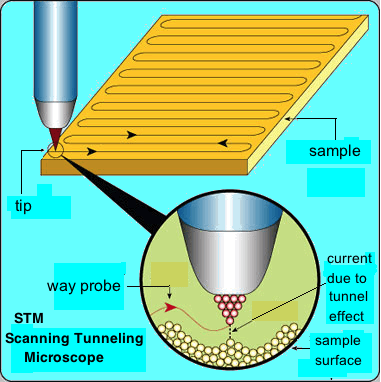

STM: SCANNING TUNNELING MICROSCOPE
 STM
(Scanning
Tunneling
Microscope)
is a kind of scanning microscope
able to detect the surfaces of the analyzed
samples to the atomic level; the principle of operating is based on
the tunnel effect. In practice, an ultra-thin probe, usually an
electric wire, with a tip composed of a very few atoms of tungsten,
platinum-iridium or gold, is approached to the atoms of the sample
surface, at a distance approximately equal to 1 nanometer; in this
way the overlap is obtained between the electron cloud of the atom,
at the end of the probe, and the electron cloud of the atom of the
sample surface that has to be analyzed. If a small potential
difference is applied to the STM, an electric current will flow
between the two electronic clouds; this current is due to quantum
tunneling effect and depends on the distance between the probe and
the sample. A software keeps constant the current while the probe is
raised and lowered, following the contours of the electronic clouds,
in order to obtain a topography of the sample surface. This kind of
microscope provides maps of conductive samples in high
resolutions up to 0,2 nm - 0,6 nm.
STM
(Scanning
Tunneling
Microscope)
is a kind of scanning microscope
able to detect the surfaces of the analyzed
samples to the atomic level; the principle of operating is based on
the tunnel effect. In practice, an ultra-thin probe, usually an
electric wire, with a tip composed of a very few atoms of tungsten,
platinum-iridium or gold, is approached to the atoms of the sample
surface, at a distance approximately equal to 1 nanometer; in this
way the overlap is obtained between the electron cloud of the atom,
at the end of the probe, and the electron cloud of the atom of the
sample surface that has to be analyzed. If a small potential
difference is applied to the STM, an electric current will flow
between the two electronic clouds; this current is due to quantum
tunneling effect and depends on the distance between the probe and
the sample. A software keeps constant the current while the probe is
raised and lowered, following the contours of the electronic clouds,
in order to obtain a topography of the sample surface. This kind of
microscope provides maps of conductive samples in high
resolutions up to 0,2 nm - 0,6 nm.